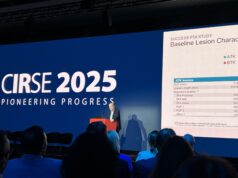
Reviewing the available evidence for below-the-ankle interventions in the treatment of critical limb-threatening ischaemia (CLTI), Srini Tummala proposes that pedal artery intervention “should be an integral part of the armamentarium” when physicians are faced with patients with both below-the-knee and below-the-ankle disease. Although he calls for more data to consolidate this view, he highlights how the existing literature demonstrates a higher rate of wound healing and a shorter time to wound healing when additional pedal artery revascularisation is performed with below-the-knee interventions.
CLTI is the most severe form of peripheral arterial disease (PAD), and is classified by ischaemic rest pain, ulcers, or gangrene in the lower extremities attributed to objectively proven arterial steno-occlusive disease. Diabetes is a major risk factor, resulting in atherosclerosis occurring at a younger age and affecting mostly the infrapopliteal arteries.1 Revascularisation with bypass or endovascular therapy (EVT) is an important treatment to avoid or minimise amputation based on the latest guidelines.2–4 Surgical bypass, however, is not always an option, as many CLTI patients with infrapopliteal disease may not be surgical candidates due to frailty, co-morbidities, advanced age, or poor distal bypass targets. 2–4 EVT for infrapopliteal disease has become commonplace, and studies have shown a comparable limb salvage rate to surgery, but there is still an apparent discrepancy between limb salvage rate and the rate of wound healing.5–10 Delayed wound healing has increased morbidity, lowers quality of life, and also increases medical costs even if limb loss is successfully prevented.6,9,10 Clinical trials have reported that the presence of below-the-ankle disease results in worse wound healing, thus pedal artery revascularisation is of paramount importance to achieve complete wound healing.7,10
About a decade ago, the safety and effectiveness of below-the-ankle angioplasty was unclear, and it was uncertain whether additional below-the-ankle angioplasty after below-the-knee (BTK) angioplasty improved clinical outcomes.11 Since then, new tools have been introduced, and many advanced techniques have been described for pedal artery revascularisation, but the lack of randomised controlled trial data and long-term results, coupled with the potential risks (including dissection, spasm, rupture, and thrombosis), have limited widespread adoption of these interventions.12–18
In 2009, Manzi and colleagues showed that below-the-ankle interventions in CLTI patients were not only feasible, but safe, and that they appeared to provide positive clinical results at both short and mid-term follow-up. In their analysis, they consecutively treated a total of 1,331 patients with BTK disease of which 135 (10.1%) underwent below-the-ankle revascularisation with pedal-plantar loop technique in order to recanalise the pedal arteries. Technical success for the pedal-plantar loop technique was 85%. Clinical improvement and functional status was obtained and maintained after an average of 12 months, with a significant improvement of transcutaneous oxygen tension (TcPO2) after 15 days. TcPO2 was 59+/-16mmHg in the below-the-ankle intervention group when it was successful versus 42+/-12mmHg in patients where patency was achieved in two BTK vessels down to the ankle level with partial out-flow in the foot (p<0.001).18
Shortly thereafter, Kawarada et al described a pedal arch classification system and demonstrated that the status of the pedal arch was an independent predictor of wound healing. Based on data from the RENDEZVOUS registry, Nakama et al demonstrated that the speed and extent of wound healing was improved with below-the-ankle angioplasty.19,20 This registry was multicentre, and included 317 CLTI patients presenting with infrapopliteal arterial disease who underwent EVT at five experienced cardiovascular centers in Japan. Nakama et al retrospectively reviewed 257 of these CLTI patients who presented with de novo infrapopliteal and pedal artery disease. Patients were then divided into two groups according to whether pedal artery angioplasty (PAA) was performed (n=140) or not (n=117). The rate of wound healing was higher in the PAA group (57.5% vs. 37.3%, p=0.003), and the time to wound healing shorter (211 days vs. 365 days; p=0.008).
More recently, in 2019, Huizing et al published a systematic review and meta-analysis of below-the-ankle angioplasty in CLTI patients. Their review included ten articles which reported a total of 478 patients with below-the-ankle angioplasty performed in 524 legs. The pooled 12-month limb salvage rate was 92%, and there was no statistically significant difference found in limb salvage when additional below-the-ankle angioplasty was compared to BTK angioplasty only. The pooled 12-month amputation-free survival was 78% and no statistically significant difference was found in amputation-free survival when additional below-the-ankle angioplasty was compared to BTK angioplasty only. This systematic review and meta-analysis showed that additional below-the-ankle angioplasty is a safe and feasible procedure, with a 92% pooled proportion of limb salvage at 12 months. Although no significant difference was found in limb salvage rates or amputation-free survival rates when BTK angioplasty only was compared to BTK angioplasty plus additional below-the-ankle angioplasty, the wound healing rates were better in the additional below-the-ankle angioplasty group. Specifically, Nakama et al in 2016 and 2017 showed wound healing rates of 93% versus 60%, and 59% versus 38%, respectively, favouring additional below-the-ankle angioplasty. Finally, with more severe pedal artery disease, wound healing results were better in the additional below-the-ankle angioplasty group compared to the BTK angioplasty only group.11
In conclusion, the currently available evidence suggests that pedal artery revascularisation is a safe and feasible procedure. Data also suggest no significant difference in limb salvage rates or amputation-free survival when additional below-the-ankle angioplasty was compared to BTK angioplasty only. However, wound healing rates are higher and time to wound healing shorter when patients undergo additional pedal artery revascularisation. This begs the question—is pedal artery revascularisation ready for prime time? While high-quality research is most certainly needed to clarify the benefits, available evidence suggests pedal artery intervention should be an integral part of the armamentarium to treat CLTI patients when there is BTK and co-existing below-the-ankle disease in cases of wound healing and limb salvage.
Srini Tummala is the director of the Limb Preservation Program, Department of Interventional Radiology at the University of Miami Health System, UM Miller School of Medicine, Miami, USA.
References
- Marco Manzi, Giacomo Cester, Luis M Palena, Josef Alek, Alessandro Candeo, Roberto Ferraresi. Vascular Imaging of the Foot: The First Step Toward Endovascular Recanalization. Radiographics. 2011 Oct; 31(6): 1,623–36.
- Norgren L, Hiatt WR, Dormandy JA, Nehler MR, Harris KA, Fowkes FG. TASC II Working Group. Inter-society consensus for the management of peripheral arterial disease (TASC II). Eur J Vasc Endovasc Surg 2007; 33(Suppl. 1): S1e75.
- Anderson JL, Halperin JL, Albert NM, Bozkurt B, Brindis RG, Curtis LH, et al. Management of patients with peripheral artery disease (Compilation of 2005 and 2011 ACCF/AHA guideline recommendations): a report of the American College of Cardiology Foundation/American Heart Association task force on practice guidelines. Circulation 2013; 127: 1425e43.
- Tendera M, Aboyans V, Bartelik ML, Baumgartner I, Clement D, Collet JP, et al. ESC guidelines on the diagnosis and treatment of peripheral artery diseases. Eur Heart J 2011; 32: 2851e906.
- Romiti M, Albers M, Brochado-Neto FC, Durazzo AE, Pereira CA, De Luccia N. Meta-analysis of infrapopliteal angioplasty for chronic critical limb ischemia. J Vasc Surg 2008; 47: 975e81.
- Iida O, Soga Y, Hirano K, et al. Midterm outcomes and risk stratification after endovascular therapy for patients with critical limb ischaemia due to isolated below-the-knee lesions. Eur J Vasc Endovasc Surg 2012; 43: 313–21.
- Kawarada O, Fujihara M, Higashimori A, et al. Predictors of adverse clinical outcomes after successful infrapopliteal intervention. Catheter Cardiovasc Interv 2012; 80: 861–71.
- Iida O, Soga Y, Yamauchi Y, et al. Clinical efficacy of endovascular therapy for patients with critical limb ischemia attributable to pure isolated infrapopliteal lesions. J Vasc Surg 2013; 57: 974–81.
- Kobayashi N, Hirano K, Nakano M, et al. Predictors of non-healing in patients with critical limb ischemia and tissue loss following successful endovascular therapy. Catheter Cardiovasc Interv 2015; 85: 850–8.
- Shiraki T, Iida O, Takahara M, et al. Predictors of delayed wound healing after endovascular therapy of isolated infrapopliteal lesions under- lying critical limb ischemia in patients with high prevalence of diabetes mellitus and hemodialysis. Eur J Vasc Endovasc Surg 2015; 49: 565–73.
- Eline Huizing, Michiel A Schreve, Jean-Paul PM de Vries, Roberto Ferraresi, Steven Kum, Çagdas ̧ Ü Below-the-Ankle Angioplasty in Patients with Critical Limb Ischemia: A Systematic Review and Meta-Analysis. J Vasc Interv Radiol 2019; 30: 1,361–1,368.
- Bolia A. Subintimal angioplasty in lower limb ischaemia. J Cardiovasc Surg (Torino) 2005; 46(4): 385–394.
- Montero-Baker M, Schmidt A, Bräunlich S, et al. Retrograde approach for complex popliteal and tibioperoneal occlusions. J Endovasc Ther 2008; 15(5): 594–604.
- Spinosa DJ, Harthun NL, Bissonette EA, et al. Subintimal arterial flossing with antegrade-retrograde intervention (SAFARI) for subintimal recanalization to treat chronic critical limb ischemia. J Vasc Interv Radiol 2005; 16(1): 37–44.
- Gandini R, Pipitone V, Stefanini M, et al. The “Safari” technique to perform difficult subintimal infragenicular vessels. Cardiovasc Intervent Radiol 2007; 30(3): 469–473.
- Graziani L, Silvestro A, Monge L, et al. Transluminal angioplasty of peroneal artery branches in diabetics: initial technical experience. Cardiovasc Intervent Radiol 2008; 31(1): 49–55.
- Fusaro M, Dalla Paola L, Brigato C, et al. Plantar to dorsalis pedis artery subintimal angioplasty in a patient with critical foot ischemia: a novel technique in the armamentarium of the peripheral interventionist. J Cardiovasc Med (Hagerstown) 2007; 8(11): 977–980.
- Manzi M, Fusaro M, Ceccacci T, Erente G, Dalla Paola L, Brocco E. Clinical results of below-the knee intervention using pedal-plantar loop technique for the revascularization of foot arteries. J Cardiovasc Surg (Torino) 2009; 50(3): 331–337.
- Osami Kawarada, Masahiko Fujihara, Akihiro Higashimori, Yoshiaki Yokoi, Yasuhiro Honda, Peter J Fitzgerald. Predictors of Adverse Clinical Outcomes After Successful Infrapopliteal Intervention. Catheterization and Cardiovascular Interventions 2012, 80: 861–871.
- Tatsuya Nakama, Nozomi Watanabe, Takuya Haraguchi, Hiroshi Sakamoto, Daisuke Kamoi, Yoshinori Tsubakimoto, Kenji Ogata, Katsuhiko Satoh, Kazushi Urasawa, Hiroshi Andoh, Hiroshi Fujita, Yoshisato Shibata. Clinical Outcomes of Pedal Artery Angioplasty for Patients With Ischemic Wounds Results From the Multicenter RENDEZVOUS Registry JACC: Cardiovascular Interventions 2017, Vol. 10, N 1: 79-90.










